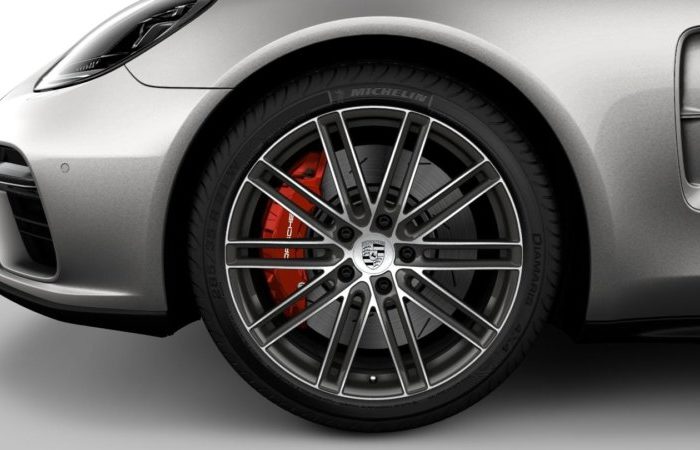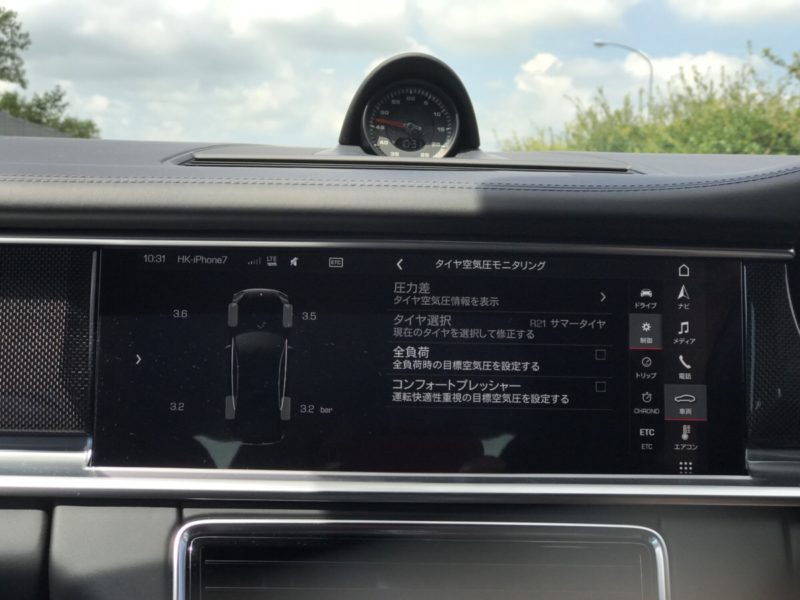How to Properly Inflate Porsche Tires (For Models with TPM)
公開日:2018.08.17

コンテンツ
Porsche Vehicles Are Equipped with Tire Pressure Monitors
This time, I’m writing about “How to Properly Inflate Porsche Tires.” However, the method introduced here applies specifically to models equipped with the Tire Pressure Monitoring system (TPM).
TPM is a feature installed on Porsche models from the 997 onwards, which displays the tire pressure of each front and rear tire on the instrument cluster. It detects slow pressure drops caused by natural leakage or foreign objects puncturing the tire and issues warnings to ensure safety. (Sudden pressure drops from unexpected external causes, like a rapid tire puncture, cannot be detected or warned.)
With that said, I’ll base this explanation on our family’s 971 Panamera.
Comfort or Standard Pressure?
Before inflating your tires, there’s an important point to check: whether you want your Porsche’s tire pressure set to “Standard Pressure” or “Comfort Pressure.” When purchasing the car, the dealer often pre-sets one of these modes, so it’s a good idea to adjust it according to your preference. Here are the differences:
■Standard Pressure: The usual Porsche tire pressure for typical driving comfort. It’s set a bit firmer.
■Comfort Pressure: A slightly reduced, softer setting to improve ride comfort.
From the touchscreen, navigate to “Vehicle → Control Vehicle → Tire Pressure Monitoring,” and checking the Comfort Pressure box switches to Comfort Pressure; unchecking it reverts to Standard Pressure.

One important note: Comfort Pressure is only valid up to 160 km/h in Japan, so exceeding that speed will trigger a warning. (In Germany, it’s valid up to 270 km/h, and for the Boxster, it’s 270 km/h even in Japan.) While you might never drive over 160 km/h on Japanese roads, if you find the warnings annoying, it’s better to stick with Standard Pressure. Our family prefers a firmer ride, so we keep it on Standard Pressure.
The Correct Way to Inflate Porsche Tires
When inflating tires, you’ll use the “Tire Pressure” display on the instrument cluster as a reference, but there’s a crucial point to keep in mind: do not adjust the pressure based on the “current pressure” reading. For example, don’t think “I want 2.5 bar, but it currently shows 2.2 bar, so I’ll add 0.3 bar.”
This is because the “current pressure” reading does not take tire temperature into account. (The standard tire pressure is based on a cold tire temperature of 20°C.) Usually, you drive to the gas station before inflating, which raises the tire temperature and pressure during driving. Inflating at this point will cause the pressure to be too low once the tires cool down.
The Panamera manual states:
Tire Pressure → The displayed current pressure is for information only. Tire pressure varies with temperature. Under no circumstances should you adjust tire pressure based on this display.
So what should you base your adjustments on? It’s the “pressure deviation” value within the “Tire Pressure” menu. This “pressure deviation” accounts for tire temperature and shows the difference from the specified pressure for each wheel.
.jpg)
In the image above, the right rear wheel shows “−0.1 bar,” meaning “Add 0.1 bar of air to the right rear tire.” Adjust the tire pressures based on these readings until all four wheels show “0.0 bar.”
If you have a gas station attendant inflate your tires, you must instruct them not by saying “Set it to 2.8,” but rather “Add 0.3 more,” or similar.
Tire Pressure Affects Ride Comfort
After inflating the tires this way and driving, you’ll notice how light the tires feel and how clearly the rolling resistance improves. On rough roads, you might feel a slight bounce, but on smooth surfaces, the ride feels silky smooth. When cornering at a brisk pace, you can feel the tires gripping firmly without any looseness. My husband said,
“Now I get why when I took delivery of my Boxster, the dealer’s H-san said, ‘When adjusting tire pressure, always use the car’s display, not the air pump’s gauge.’ This is super important!”
The manual also advises checking tire pressure at least once every two weeks when the tires are cold. Our family checks about once a month, but especially in summer, the pressure drops more frequently, so regular checks are recommended.
…That said, I’ve never actually inflated the tires myself (I’m usually just the one telling my husband at the gas station, “Add 0.1 more! Oh, too much! Now it’s +0.1!” lol), so I’m thinking I really should try doing it myself sometime soon.
このブログが気に入ったらフォローしてね!


Comment ( 0 )
Trackbacks are closed.
No comments yet.